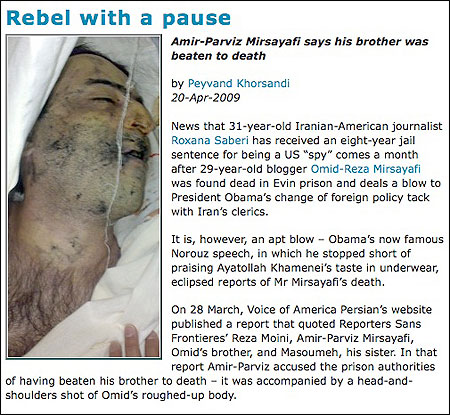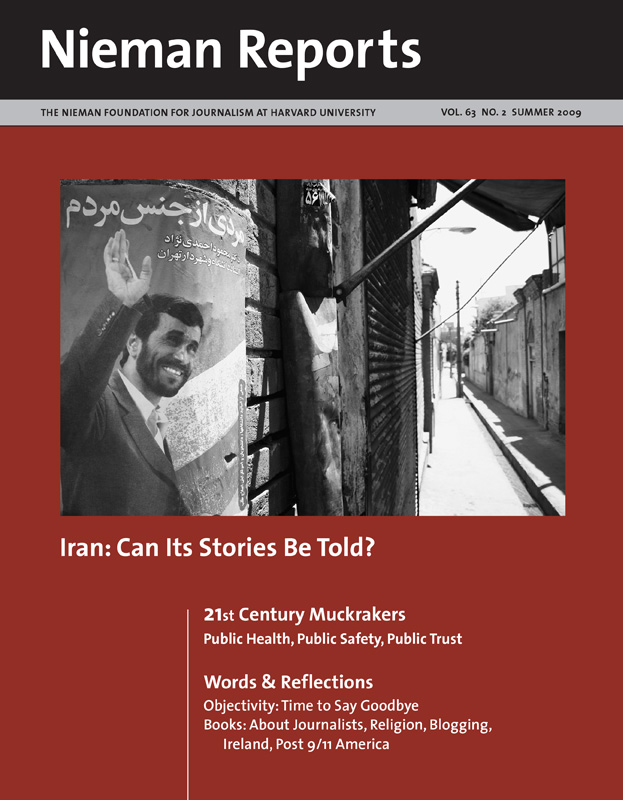Hardly a week goes by without Iran being featured prominently in the news. Usually the news is about the country’s President Mahmoud Ahmadinejad’s inflammatory rhetoric or its nascent nuclear program. But Iran is not the monolithic entity it is often portrayed to be in Western, and especially U.S., media.
While the Iranian government retains a monopoly on all television and radio broadcasting, the country continues to have an independent, though reduced in size and severely battered, print media. Although many independent and reformist newspapers were launched during the years of the Khatami presidency (1997-2005), hardliners in Iran have shut down more than 100 of those publications and jailed dozens of journalists in the process.
It is perhaps no surprise then that during those years Iranians began taking to the Internet in droves. Between 20 and 25 million Iranians have regular digital access, giving the country the highest Internet penetration rate in the region. According to research by the Berkman Center for Internet & Society, the Iranian blogosphere currently boasts some 60,000 regularly updated blogs of virtually every political stripe. Others estimate that the number is closer to 100,000. Even Iran’s president and supreme leader maintain blogs. “Weblogistan,” as Iranians casually refer to the teeming and diverse world of Farsi blogging, is alive and well despite a seemingly endless barrage of legal (and at times extralegal) persecutions.
The rate at which the Iranian blogosphere has grown can be attributed to a host of factors, but two stand out.
- The ability of women, ethnic minorities, and other otherwise marginalized groups—not to mention print journalists who have lost their jobs due to newspaper closures—to express themselves with relative freedom cannot be overstated. There is also a growing number of mainstream journalists who write online what they know will not be tolerated by the censors in traditional media. Additionally, the anonymity of writing online has largely eliminated a number of religious, social, and class-centered distinctions that have traditionally segregated society into segments that rarely interacted in the past.
- High rates of Internet penetration coupled with a highly literate and very young population (70 percent of Iran’s population is under 30 years of age) have also contributed to the burgeoning of blogging.

A screen grab from an Iranian.com article featuring a translated excerpt from the Voice of America Persian interview with Amir-Parviz Mirsayafi on March 28, 2009.
Government Clamps Down
Initially, the government did not implement any systematic measures to regulate the Iranian blogosphere. That soon changed when bloggers who discussed political, social, religious and cultural affairs—frequently in ways that were unimaginable in the traditional mediums of print or broadcast journalism—began to proliferate at breakneck speed.
In 2003, the government created a committee whose membership is drawn from various law enforcement, intelligence and legislative bodies and tasked it with designating and filtering “illegal” Web sites, which include but are not limited to Iranian blogs. Iran’s filtering and blocking regime has been described by various experts as second only to China’s. In late 2008, the government boasted that this committee had filtered upward of five million sites, though most independent observers believe that this number is inflated. A cybercrimes law introduced by the government in 2006 effectively put all forms of expression on the Internet on the same footing as other forms of journalism, which are governed by Iran’s restrictive and highly punitive press law of 2000.
RELATED ARTICLE
“Blogging in Iran”Since the turn of the century, when blogging started taking a foothold in Iranian society, Tehran has detained dozens—and possibly hundreds—of bloggers. Some were held for months before being acquitted, but others have had to serve lengthy prison terms. What is most peculiar is that those who feel the wrath of the state often don’t fit the mold of the pro-Western, anticlerical youth. For instance, theology student and blogger Mojtaba Lotfi was sentenced to a multiyear prison term after he posted a sermon by renowned theologian Hossein Ali Montazeri in 2004.
The Fate of Two Bloggers
The cases of bloggers Hossein Derakhshan and Omidreza Mirsayafi (detailed below) illustrate that what the state perceives as subversive is constantly changing. Both men found themselves in the government’s crosshairs, and in both cases the reasons for their detention remain nebulous at best.
Hossein Derakhshan: In 1999, Hossein Derakhshan was a print journalist at the reformist newspaper Asr-e Azadegan (Age of the Free People). When the popular publication was shut down in 2000, Derakhshan turned to the Web. He began to regularly write online in 2001, becoming one of Iran’s first bloggers. What propelled him to fame, however, was his development of a guide and a piece of software that enabled Farsi speakers to blog in their native tongue without having to resort to transliteration in the Roman alphabet. To this day many Farsi-language bloggers pay him homage by referring to him as the “blogfather.” Derakhshan’s blog—written for many years from Canada—cannot be accessed inside Iran. His articles have been published by many international publications, including The Guardian and The New York Times.
The Iranian judiciary confirmed in a December 30th press conference in Tehran that Derakhshan had been arrested and is in the investigative custody of a Revolutionary Court. The reason given for his detention is remarks he allegedly made on his blog about a key Shi’a cleric and the third infallible Imam of Shi’ism. The exact date of his arrest remains unknown, but Derakhshan’s last post on his blog is dated October 30, 2008. News of his detention first appeared on November 17th on Jahan News, a news Web site that is reportedly close to the Iranian intelligence apparatus. Until December 30th, authorities had denied that Derakhshan was in their custody; his whereabouts remains unknown to date.
Derakhshan rarely got into trouble with the authorities despite adopting a reformist editorial line for years. More recently, however, Derakhshan had written an increasing number of articles praising certain policies by President Ahmadinejad. Why the government arrested Derakhshan after he had softened his position vis-à-vis some hardliners within the government remains a mystery and a frequent topic of discussion on many Iranian blogs.
Omidreza Mirsayafi: On March 18th, Omidreza Mirsayafi, who wrote on the now-defunct cultural news blog Rooznegar, died under mysterious circumstances in Tehran’s notorious Evin Prison, where he was serving a 30-month term after being convicted of insulting Supreme Leader Ayatollah Ali Khamenei and Ayatollah Ruhollah Khomeini, leader of Iran’s 1979 Islamic Revolution. Mirsayafi had just begun serving his prison term in February. Mirsayafi’s lawyer said that the sentence was rushed without the proper judicial procedures and that Mirsayafi had not been officially notified of the sentence before its implementation. Mirsayafi, in an interview after being sentenced, said he had been coerced into making a false confession. He also said that the court never specified which blog entries had been deemed offensive by the government.
The prison authorities claimed that Mirsayafi had committed suicide. But the journalist’s attorney told The Times of London that Mirsayafi had repeatedly expressed concerns about his physical well-being, “but the doctors RELATED WEB LINK
Read Dr. Fairoozy’s blog entry, written in Farsi » there didn’t take this seriously and said he was faking it.” Hissam Fairoozy, an inmate at Evin, told the organization Human Rights Activists in Iran that Mirsayafi was suffering from depression and had been taking antidepressants. Fairoozy, a physician who has been repeatedly imprisoned and has in the past treated jailed political dissidents and journalists at Evin including renowned pro-democracy journalist Akbar Ganji, said that he was concerned about Mirsayafi’s condition and had unsuccessfully attempted to have prison doctors hospitalize the young blogger. (Dr. Fairoozy, after a previous stint in prison, wrote a detailed firsthand account of medical negligence in Iran’s correctional facilities on his blog.)
Mirsayafi’s brother, Amir-Parviz, also disputes the government’s rendition of events. He told Voice of America (VOA) on March 28th that his brother had no history of taking antidepressant medication and that his body showed signs of abuse, including a left ear that “was covered with blood.” VOA’s Web site posted a photo of Mirsayafi’s face that showed significant facial bruising. The government would not disclose any details about the events that led to Mirsayafi’s death and rushed to bury him within 24 hours of his death without conducting an autopsy.
Weblogistan Lives
The Iranian blogosphere continues to grow in number and impact even as the government introduces new laws and technologies to regulate it. Most observers of Iran concur that the government is not trying to end or disrupt blogging per se; rather it is involved in a constantly evolving engagement with bloggers to define the boundaries of what can be said in Iran. Weblogistan remains a place where a vigorous exchange of ideas does occur—yet it is the place where the limits of free expression in Iran are being tested.
Mohamed Abdel Dayem is program coordinator for the Middle East & North Africa Program at the Committee to Protect Journalists.


